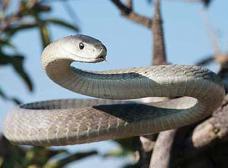Snake alert
Snake handler Nick Evans from the KZN Amphibian and Reptile Conservation shared the following article about snakes with his snake handler friend, Pieter Swanepoel from Mokopane. In the article, Evans explains to readers what to do if they should find a snake on their property, why snakes come, how to decrease the chance of them entering the property, and what to do if they encounter a snake.
For a lot of people, having a snake in the garden or in the house is considered a worst nightmare come true. Living in Africa, you’re most likely going to encounter a snake or two on your property. “It’s something we all have to deal with, just like many of us have to deal with robbers. Snakes are easier to deal with, and far less dangerous,” says Evans,
There are two main reasons why snakes are attracted to one's property, apart from their habitat being destroyed. That is food, and shelter. That’s all they’re looking for.
If you have a lot of rats around, or a lot of geckos, or a beautiful pond occupied by frogs- you’re going to get snakes looking for their lunch or dinner!
If you have piles of wood, bricks, logs, leaves etc, that too will attract snakes. Those sorts of places make for a nice, cosy retreat for them. Pool pumps are also a favourite for them, as they make for a great source of heat to give them energy. Old, abandoned sheds make for a great hideout too, especially for mambas.
So, if you don’t want snakes around, get rid of all those sort of hiding places! If
possible of course. Keep your garden nice and neat. Try to not have much vegetation growing by your windows, as that acts as a entry point for tree-climbing snakes. Those are the best things you can do.
There are many other methods that some people believe in to keep snakes away, but most of them are a waste of time and money. The truth of the matter is that there is no definite way of keeping snakes out of your garden completely.
Some people will rip out all the plants and cement the garden. This will obviously decrease the chance of snakes venturing into your property, but if you have geckos and rats, they’ll still come.
Planting Geraniums around the property won’t work either. Then there’s the classic and traditional “snake repellent”, which is Jeyes Fluid! Sorry to say, but it does not keep snakes away, not at all. Nor do the other so-called “repellents”.
Believe it or not, says Evans, snakes are great to have around the property. Snakes are your free pest control. They’ll sort out your rat problem, or gecko problem. They save you money and form a key link in the food chain too, keeping certain animal numbers in check, and they are food for other animals. Try let them be if you can.
If you see a snake in your garden, venomous or non-venomous, you can normally just leave it alone and it will disappear, and you won’t ever see it again. But obviously some of you may not want a big mamba or cobra in the garden, which is quite understandable especially if you have pets which may attack the snake.
The best thing to do is to call your local snake catcher. The same applies to if the snake is in your house, in which case, I’m sure you’ll want it taken away.
Do not ever try to catch the snake yourself, warns Evans. Even if you think you know what it is. Don’t even pick up a snake which you think is dead. There are some snakes that can play dead, but also, if a dead snakes fang penetrates your skin, there’s a chance that you could get envenomed.
Lastly, NEVER kill a snake, and not just because it plays an important role in the environment. This is when a lot of snakebites occur. So for your own safety and the snake’s, leave it alone and it will leave you alone.
Don’t live in fear of snakes, they’re not out to get us. You should rather be fearful of unfriendly humans, they’re far more dangerous!
The common highly venomous species in the area are the Mozambique Spitting Cobra, Snouted Cobra, Black Mamba, Boomslang and Puff Adder. There are no Green Mambas in the area, so don’t ‘worry’ about them. These venomous species get larger than the non-venomous snakes (well except the python obviously).
These species will also give you a warning to say ‘back off’, if you get to close. For example, the cobras may hood, the Black Mamba will show you the inside of it’s pitch-black mouth, and the Puff Adder will hiss and puff.
There many harmless species that are very common, and are often found around homes and gardens.
The Spotted Bush Snake (thin, green with black spots going half-way down the body, and a yellow underbelly) are extremely common. They’re fast moving snakes that hunt geckos. They differ from the venomous Boomslang in mainly size. Boomslang have a thicker body, larger head and larger eyes.
Then there are the Brown House Snakes (brown snake with pale lines/markings going down the body) who keep your rat population in check, and the harmless Herald Snakes (dark coloured snake, with a darker coloured head and white flecks going down the body) that keep frog numbers down.”
- Article courtesy of Nick Evans


















0 Comments